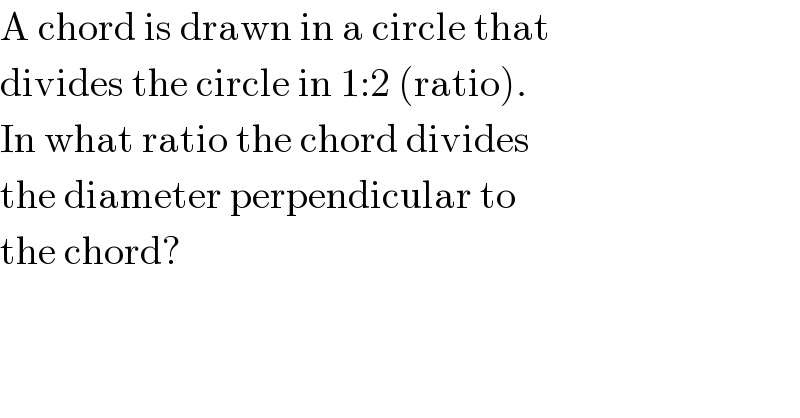Question Number 5561 by Rasheed Soomro last updated on 20/May/16

$$\mathrm{A}\:\mathrm{chord}\:\mathrm{is}\:\mathrm{drawn}\:\mathrm{in}\:\mathrm{a}\:\mathrm{circle}\:\mathrm{that} \\ $$$$\mathrm{divides}\:\mathrm{the}\:\mathrm{circle}\:\mathrm{in}\:\mathrm{1}:\mathrm{2}\:\left(\mathrm{ratio}\right). \\ $$$$\mathrm{In}\:\mathrm{what}\:\mathrm{ratio}\:\mathrm{the}\:\mathrm{chord}\:\mathrm{divides} \\ $$$$\mathrm{the}\:\mathrm{diameter}\:\mathrm{perpendicular}\:\mathrm{to} \\ $$$$\mathrm{the}\:\mathrm{chord}? \\ $$
Commented by Rasheed Soomro last updated on 20/May/16

Commented by Rasheed Soomro last updated on 20/May/16

$$\mathrm{Given}:{Area}\:\mathrm{SegmentBEC}:{Area}\mathrm{SegmentBDC}=\mathrm{1}:\mathrm{2} \\ $$$$\:\:\:\:\:\:\:\:\:\:\:\:\:\:\:\mathrm{ED}\bot\mathrm{BC} \\ $$$$\mathrm{Required}:\mathrm{EF}:\mathrm{FD}=? \\ $$
Answered by Rasheed Soomro last updated on 21/May/16

Commented by Rasheed Soomro last updated on 22/May/16
![Seg=Segment, Sec=Sector AreaSegBDC=AreaSecBDC−▲ABC Let r is radius of the circle and Central angle of secBDC=α rad. AreaSecBDC=(1/2)r^2 α ▲ABC=(1/2)r^2 sin α AreaSegBDC=(1/2)r^2 α−(1/2)r^2 sin α =(1/2)r^2 [α−sin α] AreaSegBEC=π r^2 −AreaSegBDC =π r^2 −((1/2))r^2 [α−sin α] =r^2 (π−(1/2)[α−sin α]) AreaSegBDC : AreaSegBEC=1 : 2 (((1/2)r^2 [α−sin α])/(r^2 (π−(1/2)[α−sin α])))=(1/2) (((1/2)[α−sin α])/(π−(1/2)[α−sin α]))=(1/2) α−sin α=π−(1/2)[α−sin α] 2α−2 sin α=2π−α+sin α 3α−3 sin α=2π α−sin α=(2/3)π Now in △AFB ∠AFB=π/2 rad ∠FAB=(α/2) rad cos(∠FAB)=((AF)/(AB))=((AF)/r) AF=r cos(α/2) DF=k=r−AF=r−r cos(α/2)=r(1−cos(α/2)) FE=2r−k=2r−r(1−cos(α/2))=r(1+cos(α/2)) ((DF)/(FE))=((r(1−cos(α/2)))/(r(1+cos(α/2))))=((1−cos(α/2))/(1+cos(α/2))) Required ratio (((DF)/(FE)))=((1−cos(α/2))/(1+cos(α/2))) ,where α is such that α−sin α=(2/3)π](https://www.tinkutara.com/question/Q5584.png)
$$\mathrm{Seg}=\mathrm{Segment},\:\mathrm{Sec}=\mathrm{Sector} \\ $$$$\mathrm{AreaSegBDC}=\mathrm{AreaSecBDC}−\blacktriangle\mathrm{ABC} \\ $$$$\:\:\:\:\:\:\:\mathrm{Let}\:\mathrm{r}\:\mathrm{is}\:\mathrm{radius}\:\mathrm{of}\:\mathrm{the}\:\mathrm{circle}\:\mathrm{and} \\ $$$$\:\:\:\:\:\:\:\mathrm{Central}\:\mathrm{angle}\:\mathrm{of}\:\mathrm{secBDC}=\alpha\:\mathrm{rad}. \\ $$$$\:\:\:\:\:\:\:\mathrm{AreaSecBDC}=\left(\mathrm{1}/\mathrm{2}\right)\mathrm{r}^{\mathrm{2}} \alpha \\ $$$$\:\:\:\:\:\:\:\:\blacktriangle\mathrm{ABC}=\left(\mathrm{1}/\mathrm{2}\right)\mathrm{r}^{\mathrm{2}} \mathrm{sin}\:\alpha \\ $$$$\mathrm{AreaSegBDC}=\left(\mathrm{1}/\mathrm{2}\right)\mathrm{r}^{\mathrm{2}} \alpha−\left(\mathrm{1}/\mathrm{2}\right)\mathrm{r}^{\mathrm{2}} \mathrm{sin}\:\alpha \\ $$$$\:\:\:\:\:\:\:\:\:\:\:\:\:\:\:\:\:\:\:\:\:\:\:\:\:\:\:\:=\left(\mathrm{1}/\mathrm{2}\right)\mathrm{r}^{\mathrm{2}} \left[\alpha−\mathrm{sin}\:\alpha\right] \\ $$$$\mathrm{AreaSegBEC}=\pi\:\mathrm{r}^{\mathrm{2}} −\mathrm{AreaSegBDC} \\ $$$$\:\:\:\:\:\:\:\:\:\:\:\:\:\:\:\:\:\:\:\:\:\:\:\:\:\:\:\:\:=\pi\:\mathrm{r}^{\mathrm{2}} −\left(\frac{\mathrm{1}}{\mathrm{2}}\right)\mathrm{r}^{\mathrm{2}} \left[\alpha−\mathrm{sin}\:\alpha\right] \\ $$$$\:\:\:\:\:\:\:\:\:\:\:\:\:\:\:\:\:\:\:\:\:\:\:\:\:\:\:\:\:=\mathrm{r}^{\mathrm{2}} \left(\pi−\frac{\mathrm{1}}{\mathrm{2}}\left[\alpha−\mathrm{sin}\:\alpha\right]\right) \\ $$$$\mathrm{AreaSegBDC}\::\:\mathrm{AreaSegBEC}=\mathrm{1}\::\:\mathrm{2} \\ $$$$\frac{\left(\mathrm{1}/\mathrm{2}\right)\mathrm{r}^{\mathrm{2}} \left[\alpha−\mathrm{sin}\:\alpha\right]}{\mathrm{r}^{\mathrm{2}} \left(\pi−\left(\mathrm{1}/\mathrm{2}\right)\left[\alpha−\mathrm{sin}\:\alpha\right]\right)}=\frac{\mathrm{1}}{\mathrm{2}} \\ $$$$\frac{\left(\mathrm{1}/\mathrm{2}\right)\left[\alpha−\mathrm{sin}\:\alpha\right]}{\pi−\left(\mathrm{1}/\mathrm{2}\right)\left[\alpha−\mathrm{sin}\:\alpha\right]}=\frac{\mathrm{1}}{\mathrm{2}} \\ $$$$\alpha−\mathrm{sin}\:\alpha=\pi−\left(\mathrm{1}/\mathrm{2}\right)\left[\alpha−\mathrm{sin}\:\alpha\right] \\ $$$$\mathrm{2}\alpha−\mathrm{2}\:\mathrm{sin}\:\alpha=\mathrm{2}\pi−\alpha+\mathrm{sin}\:\alpha \\ $$$$\mathrm{3}\alpha−\mathrm{3}\:\mathrm{sin}\:\alpha=\mathrm{2}\pi \\ $$$$\alpha−\mathrm{sin}\:\alpha=\frac{\mathrm{2}}{\mathrm{3}}\pi \\ $$$$\mathrm{Now}\:\mathrm{in}\:\bigtriangleup\mathrm{AFB} \\ $$$$\angle\mathrm{AFB}=\pi/\mathrm{2}\:\:\mathrm{rad} \\ $$$$\angle\mathrm{FAB}=\frac{\alpha}{\mathrm{2}}\:\mathrm{rad} \\ $$$$\mathrm{cos}\left(\angle\mathrm{FAB}\right)=\frac{\mathrm{AF}}{\mathrm{AB}}=\frac{\mathrm{AF}}{\mathrm{r}} \\ $$$$\mathrm{AF}=\mathrm{r}\:\mathrm{cos}\left(\alpha/\mathrm{2}\right) \\ $$$$\mathrm{DF}=\mathrm{k}=\mathrm{r}−\mathrm{AF}=\mathrm{r}−\mathrm{r}\:\mathrm{cos}\left(\alpha/\mathrm{2}\right)=\mathrm{r}\left(\mathrm{1}−\mathrm{cos}\frac{\alpha}{\mathrm{2}}\right) \\ $$$$\mathrm{FE}=\mathrm{2r}−\mathrm{k}=\mathrm{2r}−\mathrm{r}\left(\mathrm{1}−\mathrm{cos}\frac{\alpha}{\mathrm{2}}\right)=\mathrm{r}\left(\mathrm{1}+\mathrm{cos}\frac{\alpha}{\mathrm{2}}\right) \\ $$$$\frac{\mathrm{DF}}{\mathrm{FE}}=\frac{\mathrm{r}\left(\mathrm{1}−\mathrm{cos}\frac{\alpha}{\mathrm{2}}\right)}{\mathrm{r}\left(\mathrm{1}+\mathrm{cos}\frac{\alpha}{\mathrm{2}}\right)}=\frac{\mathrm{1}−\mathrm{cos}\frac{\alpha}{\mathrm{2}}}{\mathrm{1}+\mathrm{cos}\frac{\alpha}{\mathrm{2}}} \\ $$$$\mathrm{Required}\:\mathrm{ratio}\:\left(\frac{\mathrm{DF}}{\mathrm{FE}}\right)=\frac{\mathrm{1}−\mathrm{cos}\frac{\alpha}{\mathrm{2}}}{\mathrm{1}+\mathrm{cos}\frac{\alpha}{\mathrm{2}}}\:,\mathrm{where}\:\alpha\:\mathrm{is} \\ $$$$\mathrm{such}\:\mathrm{that}\:\:\:\:\alpha−\mathrm{sin}\:\alpha=\frac{\mathrm{2}}{\mathrm{3}}\pi \\ $$$$ \\ $$
